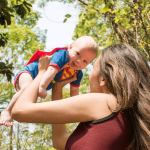
24 Jan Introducing Your Baby To The Pool
Is pool time with your baby more traumatic than fun? Here’s some advice to get them happily splashing about.
Watching my 10-month-old nephew splashing in the pool and squealing with delight, it seems any moment he’ll sprout fins and become a fish. But not all babies take to water so naturally, and the thought of introducing an anxious baby to your backyard pool can be daunting.
I had a chat with Amy Peden from Royal Life Saving Society – Australia (RLSSA), about how to make your baby’s first splash enjoyable. She says getting into the pool is a great chance to have some bonding time with your child. There’s no ‘right’ time to do this, but most parents feel confident handling their baby in water from about three to six months old.
Check the Pool
You should also check the chemical balance of the pool to prevent the growth of bacteria, and the water should be tested regularly, says Amy. If you’re unsure, your local pool store can do a pool health check for you.
When you’re ready to take your first dip, the experience should feel safe and relaxing for your baby. Amy recommends cradling your baby and moving them forwards and backwards, allowing them to feel the movement of the water. As they develop postural control, you can provide support under their head using your shoulder or hand, or under their armpits in either a front or back floating position. Keep your baby relaxed by singing and chatting to them.

Take it Slow
If your baby is anxious or scared, never force them to enter the water. “Patience and perseverance will be the winners at the end of the day,” says Amy. Start small and try sitting on the pool step with your baby on your lap, or sitting together on the edge of the pool and splashing your feet in the water. Keep the experience calm and relaxing and avoid having older children playing or jumping into the pool, making loud noises, shouting or causing waves or splashing your baby. According to Amy, short pool sessions are the most beneficial. “Keep calm, speak softly to your baby and focus on making it a fun experience.”
Quick Tips
- Babies should always wear a swim nappy to prevent any accidents in the pool.
- From about six months old babies can start water-familiarisation lessons.
- Don’t submerge your baby’s head under water. This is best done under the supervision of a qualified swimming and water-safety teacher. Instead, try getting them used to the feeling by dribbling water over their head.
- There’s no need for goggles at first. If children ever fall into the pool, it’s unlikely they’ll be wearing goggles, so it’s important they are comfortable in the water without goggles.
- Don’t use any flotation devices at first. Get your baby used to being in the water and experiencing what it feels like without artificial buoyancy aids such as floaties.
- Pool toys can be fun, but they can also be tempting for children. Actively supervise children with toys and put them out of sight afterwards. See the RLSSA factsheet on supervision.
- Monitor your baby’s temperature, as they can’t self-regulate body temperature like adults. Consider pool and air temperature, and if you notice signs such as a blue tinge around the lips, it’s time to hop out.
Amy Peden is the national manager, research and policy at Royal Life Saving Society – Australia.
Words by J. Shilson-Josling




